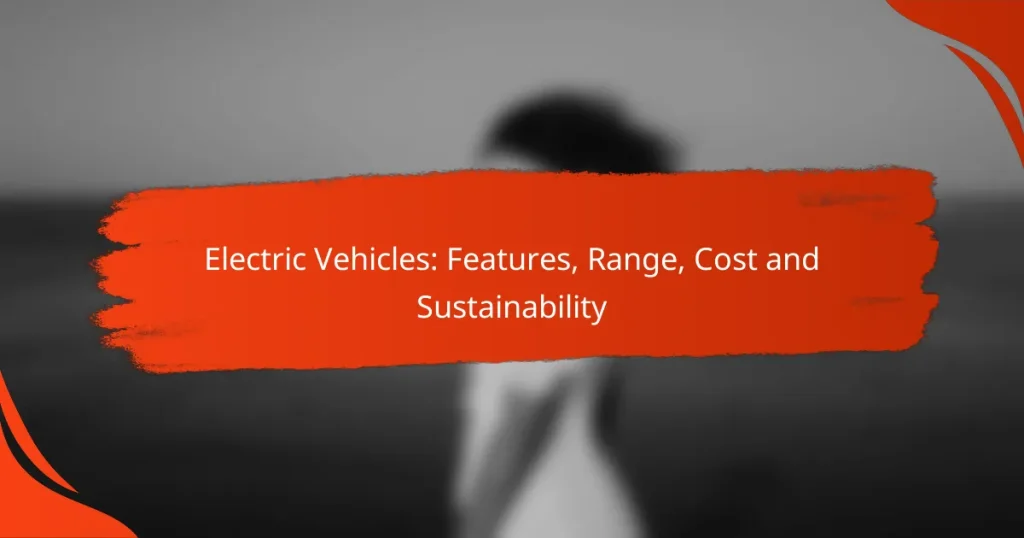Green transportation encompasses a variety of eco-friendly travel options designed to minimize environmental impact and promote sustainability. By embracing methods such as electric vehicles, bicycles, and public transit, individuals and communities can significantly reduce carbon emissions and enhance overall quality of life. Making informed choices about transportation not only supports personal mobility but also contributes to a healthier planet.
Travel Emissions: Offsetting Methods, Tools and Best Practices
Electric Vehicles: Features, Range, Cost and Sustainability
Bicycle Brands: Sustainability Practices, Materials and Certifications
Sustainable Travel Destinations: Eco-Conscious Options, Activities and Accommodations
Public Transportation: Environmental Benefits, Accessibility and Cost Savings
Eco-Friendly Road Trip: Planning, Packing, Routes and Activities
What are the benefits of green transportation?
Green transportation offers numerous advantages, including reduced environmental impact, cost savings, and improved quality of life. By adopting sustainable practices, communities can enhance mobility while minimizing pollution and energy consumption.
Reduced carbon emissions
One of the primary benefits of green transportation is the significant reduction in carbon emissions. Electric vehicles (EVs), public transit, and cycling produce far fewer greenhouse gases compared to traditional gasoline-powered vehicles. This shift not only helps combat climate change but also contributes to cleaner air quality.
For instance, transitioning to electric buses can lower emissions by up to 70% compared to diesel buses. Communities that invest in green transportation infrastructure often see a marked decrease in overall carbon footprints.
Lower fuel costs
Green transportation can lead to substantial savings on fuel expenses. Electric vehicles typically cost less to operate than their gasoline counterparts, with electricity prices often being lower than fuel prices. For example, charging an EV can cost about one-third of the price of filling a gas tank.
Additionally, using public transportation can save individuals hundreds of dollars annually on fuel and maintenance costs. Carpooling and biking also reduce personal fuel expenditures while promoting a more sustainable lifestyle.
Improved public health
Green transportation contributes to better public health by reducing air pollution and encouraging physical activity. Less reliance on fossil fuels leads to fewer harmful emissions, which can decrease respiratory illnesses and other health issues linked to poor air quality.
Moreover, promoting walking and cycling not only fosters a healthier population but also reduces traffic-related accidents. Cities that prioritize green transportation often report lower rates of obesity and related health problems.
Enhanced urban mobility
Green transportation systems improve urban mobility by providing efficient and accessible options for residents. Public transit, bike-sharing programs, and pedestrian-friendly infrastructure help alleviate traffic congestion and reduce travel times.
For example, cities that implement dedicated bike lanes and expanded public transit networks often experience smoother traffic flow and increased accessibility for all residents, including those without access to private vehicles.
Increased energy efficiency
Green transportation methods are generally more energy-efficient than traditional vehicles. Electric cars, for instance, convert a higher percentage of energy from the grid to power at the wheels compared to gasoline engines, which lose much of their energy to heat.
Investing in energy-efficient public transit options, such as light rail or electric buses, can further enhance overall energy savings. Communities that prioritize these technologies can significantly reduce their energy consumption while promoting sustainable practices.
What are the types of green transportation options available?
Green transportation options include various eco-friendly modes of travel that reduce carbon emissions and reliance on fossil fuels. Key types include electric vehicles, bicycles, public transit systems, and carpooling or ride-sharing services.
Electric vehicles (EVs)
Electric vehicles (EVs) are powered by electricity rather than gasoline or diesel, making them a cleaner alternative for personal and commercial transport. They typically use rechargeable batteries, which can be charged at home or at public charging stations.
When considering EVs, look for models that meet your range needs and budget. Many countries offer incentives such as tax credits or rebates to encourage EV adoption, which can significantly lower the initial cost.
Bicycles and e-bikes
Bicycles and electric bicycles (e-bikes) are efficient, low-cost options for short-distance travel. They produce no emissions and can often navigate traffic more easily than cars.
Investing in a quality bike or e-bike can enhance your commuting experience. Consider local bike lanes and paths to ensure safe travel, and check if your city offers bike-sharing programs for added convenience.
Public transit systems
Public transit systems, including buses, trains, and trams, provide an efficient way to reduce individual carbon footprints. They are often more affordable than owning a vehicle and can help alleviate traffic congestion.
Familiarize yourself with local schedules and routes to maximize the benefits of public transit. Many cities offer monthly passes that can save you money if you use the system regularly.
Carpooling and ride-sharing
Carpooling and ride-sharing services allow multiple passengers to share a single vehicle, reducing the number of cars on the road and lowering emissions. These options can be more economical and convenient than driving alone.
To get started, consider using apps that facilitate ride-sharing or check local community boards for carpooling opportunities. Always prioritize safety by verifying driver credentials and sharing your travel plans with someone you trust.
How can I choose the right green transportation method?
Choosing the right green transportation method involves assessing your travel needs, evaluating cost-effectiveness, and considering environmental impact. Each of these factors plays a crucial role in making an informed decision that aligns with your sustainability goals.
Assessing travel needs
Start by identifying the purpose and frequency of your travel. Are you commuting daily, running errands, or planning long-distance trips? Understanding your travel patterns will help you determine which green transportation options are most suitable.
Consider the distance you typically travel and the number of passengers. For short distances, walking or biking may suffice, while longer trips might require electric vehicles or public transit. Assessing these needs will guide you toward the most efficient choice.
Evaluating cost-effectiveness
Cost-effectiveness is a key factor in selecting a green transportation method. Compare the upfront costs, maintenance, and fuel expenses of options like electric vehicles, public transport, or biking. Electric vehicles may have higher initial costs but lower fuel expenses over time.
Additionally, consider any available incentives or subsidies for green transportation in your area. Many governments offer tax credits or rebates for electric vehicle purchases, which can significantly reduce overall costs. Factor these into your decision-making process.
Considering environmental impact
When evaluating green transportation methods, it’s essential to consider their environmental impact. Electric vehicles produce zero tailpipe emissions, while public transport can significantly reduce per-passenger emissions compared to single-occupancy vehicles.
Research the source of electricity for electric vehicles in your region. If the power comes from renewable sources, the environmental benefits increase. Also, consider the lifecycle emissions associated with manufacturing and disposing of vehicles, as this can influence the overall sustainability of your choice.
What are the costs associated with green transportation?
The costs of green transportation can vary significantly based on the mode of transport, such as electric vehicles (EVs) or bicycles. Key considerations include initial purchase prices, ongoing maintenance, and infrastructure expenses.
Initial purchase price of EVs
The initial purchase price of electric vehicles (EVs) can be higher than that of traditional gasoline-powered cars. Prices typically range from around $30,000 to over $100,000, depending on the model and features. However, many governments offer incentives and rebates that can reduce the effective cost.
When considering an EV, it’s essential to factor in potential savings on fuel and maintenance over time, which can offset the higher upfront investment. Additionally, some regions have programs that provide financial assistance for EV purchases, making them more accessible.
Charging infrastructure expenses
Setting up charging infrastructure can incur additional costs for EV owners. Home charging stations can range from $500 to $2,000, depending on installation complexity and equipment. Public charging stations may also charge fees that vary widely based on location and provider.
It’s crucial to evaluate the availability of charging stations in your area and consider whether you will need to install a home charger. Some workplaces offer charging options, which can help mitigate costs associated with charging infrastructure.
Maintenance costs of bicycles
The maintenance costs of bicycles are generally lower than those for motor vehicles. Basic upkeep, such as tire inflation, brake adjustments, and chain lubrication, can cost around $50 to $100 annually. However, more significant repairs or upgrades may increase expenses.
Regular maintenance is essential for ensuring safety and performance. Cyclists should budget for occasional tire replacements and tune-ups, which can add to the overall cost of ownership. Investing in quality components can also reduce long-term maintenance needs.
What incentives are available for adopting green transportation?
Various incentives are available to encourage the adoption of green transportation, including government tax credits, rebates for electric vehicles, and subsidized public transit fares. These incentives aim to reduce the financial burden on individuals and businesses while promoting environmentally friendly transportation options.
Government tax credits
Government tax credits can significantly lower the cost of purchasing green vehicles or implementing sustainable transportation solutions. In the United States, for example, federal tax credits for electric vehicles can range from a few thousand dollars up to $7,500, depending on the vehicle’s specifications and battery capacity.
To qualify, buyers must ensure that the vehicle meets specific criteria set by the IRS. It’s essential to consult the latest guidelines, as these credits can change based on legislation and vehicle eligibility.
Rebates for electric vehicles
Many states and local governments offer rebates for electric vehicle purchases, which can provide immediate savings at the point of sale. These rebates often range from a few hundred to several thousand dollars, depending on the state and the vehicle model.
For instance, California offers rebates up to $7,000 for eligible electric vehicles, while other states may provide lower amounts. Researching local programs can help potential buyers maximize their savings when transitioning to electric vehicles.
Subsidized public transit fares
Subsidized public transit fares make it more affordable for individuals to use buses, trains, and other forms of public transportation. Many cities offer reduced fares for seniors, students, and low-income individuals, which can significantly lower commuting costs.
In some regions, employers may also provide transit benefits, allowing employees to pay for public transit costs pre-tax. This not only saves money but also encourages the use of greener transportation options, reducing overall emissions in urban areas.






